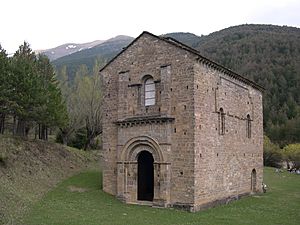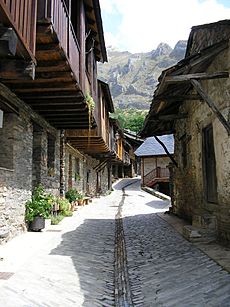Bien de Interés Cultural facts for kids

A Bien de Interés Cultural (say: bee-EN day een-tay-RES koo-too-RAL) is a special way to protect important cultural treasures in Spain. It's like a national list of things that are very valuable to Spain's history and culture. This term is also used in Venezuela and other Spanish-speaking countries.
These "cultural interest goods" are not just old buildings or artworks. They can also be things like special traditions or even languages, such as the Silbo Gomero language from the Canary Islands. Some of these special treasures are even protected by the world as World Heritage Sites.
Contents
What Are Cultural Treasures?
In Spain, the idea of protecting cultural heritage changed in 1985. Before that, important sites were called "national monuments." The new Bien de Interés Cultural category was created to protect a much wider range of cultural things. This means not just buildings, but also old objects, historical places, and even special gardens.
Types of Cultural Treasures
Bienes de Interés Cultural can be divided into two main groups:
- Movable heritage: These are things that can be moved. They include old tools from archaeological digs, important documents, and large works of art. Sometimes, these protected objects are kept inside a building that is also a protected cultural treasure!
- Non-movable heritage: These are things that cannot be moved. They are divided into different types:
* Monumento (monument): This is a single building or structure that is very important, like a famous castle or church. * Conjunto histórico (historical group or area): This means a group of buildings or a whole town that has historical importance, like an old town center. * Jardín histórico (historical garden): This is a garden that is special because of its history, design, or plants, like the Real Jardín Botánico de Madrid (Royal Botanical Garden of Madrid). * Sitio histórico (historic site): This term is used for larger historical areas or cultural landscapes, such as the old Riotinto mines. * Zona arqueológica (archaeological area): This is a place where important ancient remains have been found, like the Archaeological site of Atapuerca.
How Regions Protect Culture
Spain is divided into different regions called autonomous communities. Each region helps protect its own cultural heritage. Sometimes, these regions have slightly different ideas about what should be protected.
For example, bullfighting is a traditional event in Spain. The national government now oversees its protection. However, some regions have different views. The regional government of Madrid believes bullfighting should be protected as cultural heritage. On the other hand, the region of Catalonia once banned bullfighting, though this ban was later overturned by the highest court in Spain. This shows how different regions can have their own approaches to cultural protection.
See also
 In Spanish: Bien de interés cultural (España) para niños
In Spanish: Bien de interés cultural (España) para niños
- Lists of Bienes de Interés Cultural
- Patrimonio histórico español



